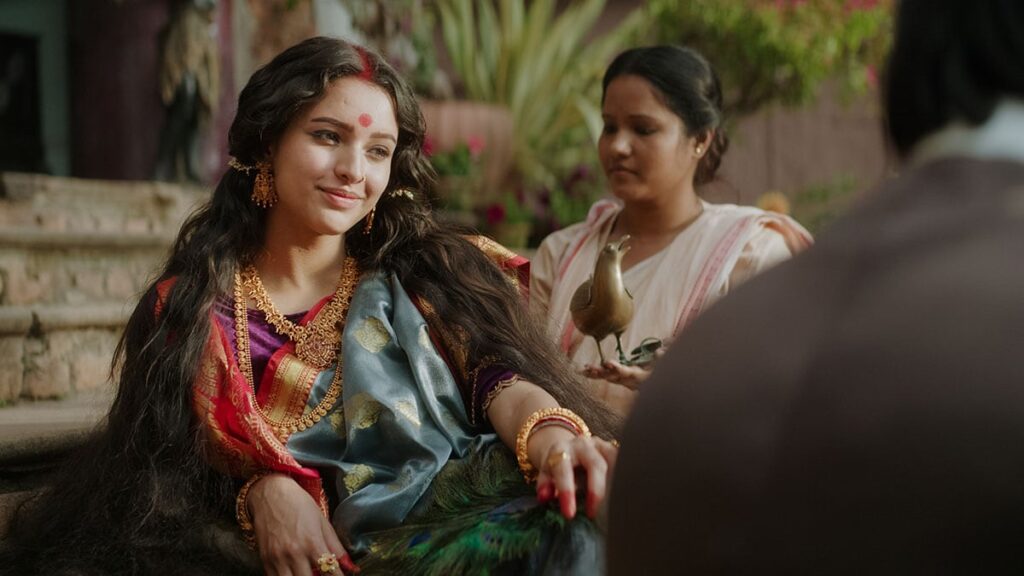‘Badi haveliyon mein bade raaz hote hain’, says Binodini when she dresses up the fiery protagonist of our supernatural feminist fable, Bulbbul. As we go on to unravel these mysteries that the large foreboding mansions entail, a blood-soaked fable reveals itself to us. Drenched in red, this directorial debut of dialogue writer and lyricist, Anvita Dutt stands true to the phrase ‘Every Frame a Painting.’
Although deep-rooted in Indianness in terms of origins, inspirations, and symbolisms, the film is less of a horror story than it is about the horrors a patriarchal society inflicts upon women. The real horror of the film lies in the grim realities that the women have to live every single day. Horror isn’t just a genre or used as a narrative device here but as a metaphor.
Set in the late 19th century, this Bengali gothic tale is about a woman whose spirit once stifled, is amplified later by her own will. The word ‘Bulbbul’ refers to a bird, and birds by their nature are free. Bulbbul is about that freedom, the seemingly horror inciting journey that a woman has to undertake in order to achieve her emancipation. Told in a non-linear fashion, the film includes carefully curated elements that make it a definite one-time watch, although the style does not work for creating suspense here.
Recommended: 58 Best Bollywood Movies On Netflix Right Now
Going from a coy child bride to an asserting thakurain of the mansion, the trajectory of Bulbbul‘s unique journey takes a larger-than-life form. Married off to a man a few decades older than her, as Bulbbul enters the haveli, she is to come-of-age in order to discover the underlying hypocrisies of the seemingly benign world.
Systems of oppression that operate against both the women in the film, Binodini (Bulbbul‘s sister-in-law, played by Paoli Dam) and Bulbbul render them without morally correct choices to go ahead with. The ‘chudail’ figure in the film hunts down men of the village, in particular, wears the ‘Daakini’s outfit (brilliantly done by costume designer Veera Kapur Ee), and avenges her fate on her own.
While we know from the very start, that Bulbbul is the witch figure as well, we are still hooked. That is mostly because of the stellar performance delivered by Tripti Dimri. Seamlessly moving from submission to revolt, Damri plays her part effectively. Despite that, one can argue that she gives too much away instead of holding information from us.
Recommended: 13 Best Bollywood Thrillers On Netflix: Talvar, Andhadhun
Coming to the character of Binodini, the defining scene that reveals her side of the repression is the one where she dresses Bulbbul up like a doll. Referred to as ‘gudiya‘ by Mahendra (played by Rahul Bose), Binodini‘s husband; she is also ironically dressed up like a ‘gudiya‘ by Binodini. The symbolism of the doll is key in the film, as it draws from folklore that is often premised around spirits that are caged within dolls.
When she is in that process of clothing Bulbbul, the backstory of her vile character gets defined for the audience, as we come to hear her iterate what she might’ve heard before she came to be a married of in the family living in the coveted giant mansion. Crafted with utmost precision, both the female characters are etched with a lot of depth. What comes to the fore at large, is how both of them are forced to resort to politics to carve out an identity for themselves.
Recommended: 30 Best Horror Movies Netflix Has To Offer
Therefore, the women in the film are products of circumstance. The film seeks to redefine the entire definition of an ‘evil woman’. By focusing on the system that renders them without a choice, except to fend for themselves by hook or by crook. It makes you empathize with both Bulbbul and Binodini for that matter. The male figures in the film, except for Satya (played by Avinash Tiwari) are symbolic of a higher patriarchy that is oppressive, cruel and unforgivably brutal. They are tools that are placed in the film, only to be killed later, which seems forced at most places.
While the film’s feminism does not falter and it simplistically furnishes its messaging, the construction of the storyline is arguably incomplete. Its flawless camerawork and design almost attempt to compensate for a lack of a concrete plot.
Besides, the film derives its crux from the effective performances delivered by the stellar cast. Rahul Bose is heinous as Indraneel and equally abominable as the developmentally challenged twin Mahendra; they evoke in us a searing hatred for tormenting Bulbbul, which I think is the hallmark of a great actor. Paoli Dam, who plays Binodini delivers all her avatars in the film with utmost precision, and it is her performance that makes us empathize even with a supposed antagonist. Parambrata Chatterjee is effortless as Dr. Sudip infusing the role with a quaint charm while successfully arousing suspicion.
Recommended: 22 Must Watch Bollywood Movies From Women Filmmakers
Cinematographer Siddharth Divan and production designer Meenal Agarwal create stunning visual atmospherics of the film. Sound designer Amit Trivedi proves his mettle in the audio department. The colour red, which is a symbol of fertility and anger appears almost universally across all scenes in the film. It acts as a recurring motif, symbolizing the protagonist’s urge to avenge by blood.
When I saw Bulbul, the title sequence sucked me in, the reds of it, I love red,Red is cinematic, visceral. What I didn’t expect were the red nights, the red moon, from a horror mystery it had transformed into a moody fable, pure poetry and it had me enthralled and engrossed .
— Anurag Kashyap (@anuragkashyap72) June 25, 2020
https://platform.twitter.com/widgets.js
Besides, the film is rife with influences from literature such as Sharatchandra Chattopadhyay’s Devdas and Rabindranath Tagore’s Chokher Bali. Right from the pairing of Binodini and Mahendra, to the childhood relationship shared between Bulbbul and Satya.
Just like Paro, our female protagonist is married off to someone much older than her and just like Devdas, Satya is sent to study law in London. These similarities aside, the aesthetic that the film tries to emulate is also derived from the paintings of Raja Ravi Varma.
Recommended: 12 Best Indian Horror Movies: ‘Eeram’ To ‘Tumbbad’
Other than the characters of the film, two other symbols play characters as well. The first case is that of the personification of the forest, that adds a thriving quality of eeriness to it. Painted in red throughout the film, the forest is not just an avenue of the witch meeting its prey. It is more so a place that practically lives the bloodlust of the witch, making it a site of great redressal.
The second example of a symbol like that is Bulbbul’s feet. It is integral to note that when the character of Bulbbul is introduced, it is not by revealing her face, but her feet. Even when we have travelled in time and Bulbbul has grown up to own the mansion like a true thakurain, the first shot is that of her feet.
The role that the pair of feet play in the film is critical, as it is on them that the bichua (toe ring) is worn to prevent the girl from flying away. As the dolled up bride steps into the crimson red alta on the wedding day, she leaves footprints of her past behind. It is on the feet that Bulbbul is hit by her husband, Indraneel. It is indeed at the site of the feet that the spirit of the woman is rendered immobile.
Recommended: 20 Best Haunted House Movies Of All Time
Although drawn heavily from our pre-existing mythologies and stories, the story is a modern retelling. Despite that, Bulbbul‘s eventual emergence as the victorious one is not something you will root for, as you can imagine the end well before the story unravels.
But, what caught my attention the most in the film, was the directorial treatment meted out to the scenes wherein the central character comes to be exploited. In the first example, during the scene when Indraneel hits Bulbbul, the slow motion shots particularly do a lot of injustice to the idea of violence and oppression as they are dealt with a lot of cinematic artistry. In the second instance, the rape scene that is held on to for longer than it is required.
With these two cinematic fallacies, the director, instead of giving an account of the backstory, ends up romanticising it.
To conclude, Bulbbul begins and ends predictably. Anvita Dutt has written the film with a sense of incompleteness that is dazed away by the atmospherics and the visuals of the film. It would not be wrong to say, that with partial character development and incomplete threads weaved into the larger fabric of the film, the film relies more on its technicalities than the quality of its story. The film succeeds on some fronts, fails on some others, but still makes for a good watch because of its relevant themes.
Rating: 3/5
Where to watch: Netflix
By Sanghmitra Jethwani
Director: Anvita Dutt
Writer: Anvita Dutt
Cast: Parambrata Chatterjee, Tripti Dimri, Paoli Dam, Rahul Bose, Avinash Tiwary
Producer: Clean Slate Pictures
Recommended: 12 Bengali Movies on Amazon Prime Worth Watching





1 thought on “Bulbbul (2020) Review: A Feministic Tale Of Love, Betrayal & Redemption”
Comments are closed.